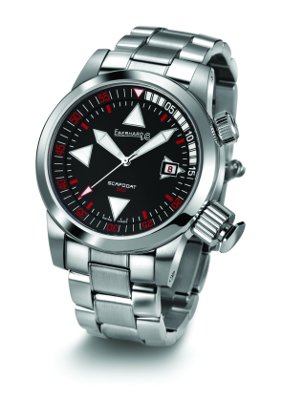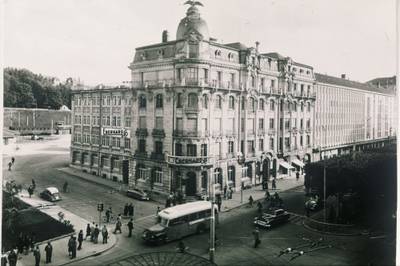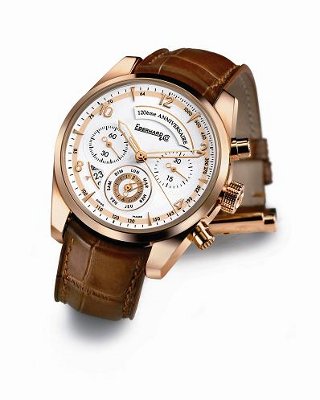 George Emile Eberhard, fondateur de la manufacture Eberhard&Co., est né en 1865 à Saint-Imier en Suisse.
George Emile Eberhard, fondateur de la manufacture Eberhard&Co., est né en 1865 à Saint-Imier en Suisse.
Son gout pour l’horlogerie il le tient de son père, lui-même horloger.
En 1887, à l’âge de 27 ans il fonde à la Chaux-de-Fonds sa manufacture.
Le lancement du premier chronographe de poche place la manufacture au rang des montres de grande précision.
En 1905 la manufacture inaugure le siège central rue Léopold Robert à la Chaux-de-Fonds.
En 1919 Georges et Maurice Eberhard, fils du fondateur, intègrent l’équipe de direction de la Maison. Cette même année, Eberhard & Co. lance un chronographe-bracelet, à attaches mobiles et fond à charnière. Le boîtier en or 18 carats devient à la fois un must incontournable et une garantie de qualité.
En 1926 les deux frères reprennent définitivement la direction de l’entreprise.
En 1935 suite aux recherches menées par la manufacture, un nouveau chronographe voit le jour: il s’agit d’un modèle à deux poussoirs avec arrêt et nouveau départ de l’aiguille du chronographe sans remise à zéro.
En 1935 la maison récidive en lançant un chronographe à bracelet, comprenant en plus du compteur d’heures un dispositif rattrapante, une technique qui permet le double chronométrage.
En 1947 l’entreprise reprend son activité et se lance sur le marché de la montre pour dame.
 Les années 50 voient naitre le modèle Extra-Fort, doté d’un poussoir à glissière permettant l’arrêt et la remise en marche du chronographe.
Les années 50 voient naitre le modèle Extra-Fort, doté d’un poussoir à glissière permettant l’arrêt et la remise en marche du chronographe.
En 1960 le dispositif de la mise au point simultanée de la date est lancé.
En 1968 les mouvements à 36.000 alternances viennent renforcer la précision des chronomètres Eberhard & Co.
En 1970 au style « sidéral » Eberhard & Co répond en lançant la collection Sirio dont la principale caractéristique est un mouvement quantièmes à quartz.
En 1987 pour fêter son centenaire Eberhard & Co présente la collection de chronographes Navymaster, dont les dates commémoratives sont reportées sur le cadran.
En 1992 la maison horlogère présente le chronographe Tazio Nuvolari en hommage à la naissance d’un des plus grand mythe de l’automobile sportive.
En 1996 la maison s’oriente vers des modèles de plus grande dimension, tels le Traversetolo (43 mm),
le Tazio Nuvolari ” Grande Taille ” (43 mm) et le Tazio Nuvolari Rattrapante ” Géant ” (51 mm) qui connaissent un grand succès.
En 1997 Eberhard & Co. présente le modèle 8 Jours, un modèle mécanique dont le remontage manuel n’est nécessaire qu’une fois tous les huit jours. L’innovation de Eberhard & Co. est le dispositif de remontage spécial formé de deux ressorts superposés qui dépassent globalement un mètre et demi de longueur. Pour permettre une comparaison, dans une montre-bracelet commune, il n’existe qu’un seul ressort long d’environ 30 cm.
 En 1999 la maison réinterprète le chronographe mythique des années 50, le modèle Extra-fort.
En 1999 la maison réinterprète le chronographe mythique des années 50, le modèle Extra-fort.
En inauguration du nouveau millénaire, la manufacture crée le chronographe Chrono 4, le premier chronographe aux compteurs sont alignés.
En 2003 , fidèle à sa tradition, Eberhard & Co. présente le chronographe “Tazio Nuvolari – Vanderbilt Cup”.
La Collection Extra-fort s’enrichit en 2004 du modèle Roue à Colonnes Grande Date, les fonctions chronographiques sont en effet directes et commandées par la roue à colonnes au moyen d’un mouvement mécanique à remontage automatique modifié.
En 2005 la maison présente le modèle Temerario, un chronographe qui réunit 3 brevets, l’un concerne la conception du mouvement, l’autre le dispositif de protection de la couronne et le troisième la fermeture de sûreté du bracelet en cuir ou en métal.
En 2006 Eberhard & Co conçoit une collection de montres de plongée dont le nom est “Scafodat”.
En 2007 la maison célèbre son 120ème anniversaire en présentant le Chronographe 120ème Anniversaire.En 2008 le Chrono 4, se présente dans une nouvelle version “Grande Taille”.
 1865
1865
George Emile Eberhard, founder of Eberhard&Co., was born in 1865 at Saint-Imier in Switzerland. His father initiated him to all the secrets of the watchmaking.In 1887 George-Emile was only 22 when he founded his firm Eberhard&Co at La Chaux-de-Fonds, and having presented its first Pocket-Watch chronograph.
1919
The founder’s sons Georges and Maurice Eberhard take charge of the “Maison”. The same year sees the launching of a wrist chronograph featuring a strap with mobile attachments and a hinged caseback. The 18 carat gold case becomes at once a must and a guarantee for product quality.
1926
From this year onwards, Georges-Emile’s heirs took full charge of the Maison, with a keen eye on the portents of the new age and its belief in progress, and on upholding that tradition which was meanwhile being universally associated with the concept of “watches by Eberhard & Co”
1930
The innovative potential of the Maison Eberhard & Co. is convincingly expressed in the creation of a new chronograph with self-winding movement – a veritable innovation in its time. During the ’30s, chronographs by Eberhard & Co. are seen adorning the wrists of the commissioned officers in the royal Italian navy.
1935
The quest of this Swiss company for more novelties gives birth to a new chronograph that features two push buttons for stopping and starting again without setting to zero.
An innovation that opened up a new possibility for the measuring of time.
1938
For the first time a wrist-watch chronograph with counter device is presented and the century of all records welcomes it with enthusiasm. Once again the creative contribution of Eberhard & Co. seals this invention.
1947
After the tail-end of World War II, the company resumes its activities. The Maison Eberhard & Co. is now venturing out also into the market for ladies’ watches. So the fair sex, too, are now gaining access to the quality and reliability of products bearing the Eberhard & Co. logo in the form of luxurious time-keeping pieces of jewellery.
1950
Towards the end of the ’50s, Eberhard & Co. present the “Extra-Fort” model with a push button for stopping
and starting the chronograph. This is truly a splendid specimen of the art of making mechanical watches
and has retained its status of much-coveted collectors’ piece to this day.
1960
The ’60s are primarily marked by the introduction of a simultaneous date setting device.
1968
Chronometers by Eberhard & Co. enter into a new era as movements performing 36,000 vibrations per hour now warrant an improved measure of precision. Along with them, the world witnesses the gradual advent
of the first electronic movements – a challenge of the zeitgeist to the future of the trade.
1970
The Sirio collection comes as Eberhard & Co.’s reaction to that very zeitgeist as the “frigid” style of these years is expressed in the elegantly refined contours of a watch, whose most characteristic feature is a newly conceived quartz-controlled calendar movement.
1980
In the early ’80s, Eberhard & Co. take pride in being the Swiss company that is launching once again
a mechanical chronograph in the market.
1984
Based on studies and research work conducted in cooperation with P.A.N. Frecce Tricolori, the company creates its “Chronomaster Frecce Tricolori”, a chronograph dedicated to the world’s most famous aerobatic squadron.
1987
As the Maison Suisse d’Horlogerie Eberhard & Co. celebrates its centenary, it takes the opportunity on this occasion to introduce its Navymaster chronographs collection, to wit an inscription on the dial commemorating these two important dates.
1992
This is another important year for Eberhard & Co. seeing that it marks the 100th birthday of the greatest racetrack champion of all times to whom the Maison Suisse pays homage by introducing its unique chronograph named the Tazio Nuvolari.
1996
The company now focuses on what you might call king-size wrist watches as it introduces such extremely successful models as the Traversetolo (43mm), the Tazio Nuvolari “Grande Taille” (43mm) and the Tazio Nuvolari Rattrapante “Géant” (51mm).
1997
Following its self-imposed commitment to ongoing research with due respect to strong tradition, Eberhard & Co. achieves another watchmaking feat in the form of a unique watch named the “8 Days”. It’s a manually winding mechanical watch that needs to be rewound every eight days only.
The company’s innovation here is a special winding device consisting of two overlapping springs, more than one metre and a half long altogether while a standard wrist watch has only one spring, about 30 cm long.
1999
Presentation of Extra-fort, a re-edition of a chronograph which in the ’50s was typical of a whole epoch.
2001
In the new millennium, Eberhard & Co. revolutionises chronograph read-off with the Chrono 4: the first chronograph in the history of watchmaking whose counters are arranged in one row.
2003
Eberhard & Co., always in search of innovation, remains nevertheless true to its own tradition. The most recent example is the “Tazio Nuvolari-Vanderbilt Cup” chronograph.
In this model, the company combines a dedication to technical progress and an exquisite nostalgia for historical details as shown in the crown with its coaxial push button.
2004
The Extra-fort Collection has been enriched by the new model Roue à Colonnes Grande Date, a chronograph
that typifies timeless elegance, in perfect harmony with tradition and innovation. It is characterised
by a technically innovative, precious movement, the chronograph’s functions being controlled
by the column-wheel by means of a modified mechanical movement with automatic winding that operates
in accordance with a new and exclusive process, namely a precise, accomplished mechanism.
2005
Following the revolutionary Chrono 4 Eberhard & Co. presents Temerario, a most daring and innovative interpretation of the chronograph, thanks to which the Maison invents a new way of measuring time. �
Chrono 4 Temerario presents itself in a completely original and unique way and boasts 3 exclusive patents developed by Eberhard & Co. One of these regards the movement, another concerns the access system to the crown, and the third relates to the safety clasp of the leather strap and the bracelet.
2006
“Scafodat” is the name of the diving-watch collection for professional use; it resumes the Eberhard & Co.’s tradition in sport watches with technical features.

2007
The Maison Suisse d’Horlogerie Eberhard & Co. celebrates its 120th anniversary.
120 years of passion for an old and fascinating art.
120 years of chronographs and watches featuring a timeless personality.
120 years telling of an illustrious past and, what is even more important, contributing to our coping
with the challenges of the future.
120 years of care and attention to every detail, all embodied in a very special chronograph: Chronographe 120ème Anniversaire.
2008
Chrono 4, the well-known chronograph that revolutionised reading the time, is launched in a new version
as “Grande Taille”, which matches perfectly the most recent trend towards oversized watches.
